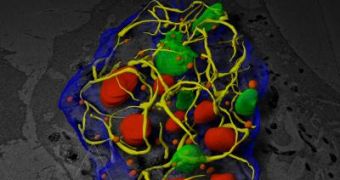Every day, someone proclaims to have found a new cure for cancer or a new cause for cancer. Many times, the same thing is labeled as both a cure and a cause, depending on the day. You can add the common cold virus to that list. But no, the cold doesn't cause or cure cancer.
But understanding how some cold viruses work could lead to understanding how cancer works as well. They key is a property of some cold viruses that disable a cell's natural defense mechanisms against infections, suicide.
Cells that have become infected will self-destruct rather than continue to act as virus factories.
However, some viruses, like the Adenovirus cold virus, are able to bypass this mechanism and prevent cells from destroying themselves.
This is part of the reason why colds can be so hard on the body, with this first defense disabled, the body has to create antibodies to fight off a lot more viruses than they would if the suicide trigger worked.
Cold symptoms such as fever, runny nose and so on are caused by the body's response not by the virus itself.
Researchers at Salk Institute have been studying the mechanism through which the cold virus disables the self-destruct trigger.
This relates to cancer because the same self-destruct mechanism is disabled in cancerous cells as well, allowing tumors to spread unchecked.
The team looked at E4-ORF3, a very peculiar protein that is created by the adenovirus and that blocks the p53 protein from binding to the genes it's supposed to.
P53 is a protein that instructs a cell to self-destruct if its DNA is severely damaged, which is the case in cancer cells. But p53 is blocked from functioning properly in the vast majority of types of cancer.
The virus uses the same method, blocking p53 to keep cells alive and continue to replicate. Scientists believe that by understanding how this works, they can both understand how p53 is blocked in cancer cells, but, more interestingly, they also hope to alter E4-ORF3 and use its capabilities of binding to various cellular components to create highly targeted cancer drugs that would prevent cancer cells from working properly.
E4-ORF3 is unique in that it's highly adaptable and is able to bind to many types of proteins and complex components found in cells and inhibit their proper functions. It's this property that researchers would like to use, providing that they are able to alter E4-ORF3 to only target cancer cells.

 14 DAY TRIAL //
14 DAY TRIAL //